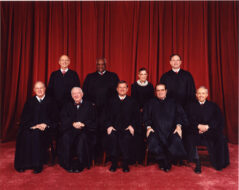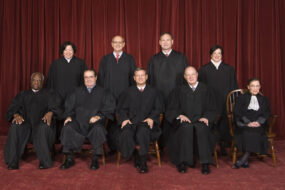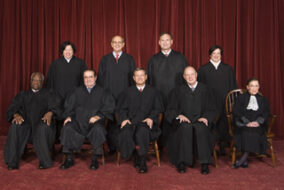
No related resources
Introduction
As the United States struggled with the issue of civil rights, another issue of rights began to gain attention: equal rights or equal opportunities for women. As with African American civil rights, the movement for women’s rights had been part of American politics since the Revolution. It too gained momentum following the Civil War; one accomplishment was the Nineteenth Amendment (1920), which gave women the right to vote. (Several states had granted them that right earlier.) Advocates for women’s rights also proposed an amendment guaranteeing equality of rights for women. First introduced in Congress in 1923, the amendment was introduced every year thereafter and passed and submitted to the states finally in 1972, with a deadline for ratification of March 22, 1979. The amendment read:
Section 1. Equality of rights under the law shall not be denied or abridged by the United States or by any State on account of sex.
Section 2. The Congress shall have the power to enforce, by appropriate legislation, the provisions of this article.
Section 3. This amendment shall take effect two years after the date of ratification.
Thirty-five of the necessary 38 states ratified the amendment before opposition to it led largely by Phyllis Schlafly stalled the process. Under pressure from women’s groups like the National Organization for Women, Congress extended the ratification deadline, but the amendment never passed. The Florida House of Representatives passed the amendment several times but the Senate did not, rejecting it by a vote of 16 for, 22 against a week before the extension deadline.
Representative Shirley Chisholm, Address to the United States House of Representatives, May 21, 1969
Mr. Speaker, when a young woman graduates from college and starts looking for a job, she is likely to have a frustrating and even demeaning experience ahead of her. If she walks into an office for an interview, the first question she will be asked is, “Do you type?”
There is a calculated system of prejudice that lies unspoken behind that question. Why is it acceptable for women to be secretaries, librarians, and teachers, but totally unacceptable for them to be managers, administrators, doctors, lawyers, and Members of Congress?
The unspoken assumption is that women are different. They do not have executive ability, orderly minds, stability, leadership skills, and they are too emotional.
It has been observed before, that society for a long time discriminated against another minority, the blacks, on the same basis – that they were different and inferior. The happy little homemaker and the contented “old darkey” on the plantation were both produced by prejudice.
As a black person, I am no stranger to race prejudice. But the truth is that in the political world I have been far oftener discriminated against because I am a woman than because I am black.
Prejudice against blacks is becoming unacceptable although it will take years to eliminate it. But it is doomed because, slowly, white America is beginning to admit that it exists. Prejudice against women is still acceptable. There is very little understanding yet of the immorality involved in double pay scales and the classification of most of the better jobs as “for men only.”
More than half of the population of the United States is female. But women occupy only 2 percent of the managerial positions. They have not even reached the level of tokenism yet. No women sit on the AFL-CIO council or Supreme Court. There have been only two women who have held Cabinet rank, and at present there are none. Only two women now hold ambassadorial rank in the diplomatic corps. In Congress, we are down to one Senator and 10 Representatives.
Considering that there are about 3 1/2 million more women in the United States than men, this situation is outrageous.
It is true that part of the problem has been that women have not been aggressive in demanding their rights. This was also true of the black population for many years. They submitted to oppression and even cooperated with it. Women have done the same thing. But now there is an awareness of this situation particularly among the younger segment of the population.
As in the field of equal rights for blacks, Spanish-Americans, the Indians, and other groups, laws will not change such deep-seated problems overnight. But they can be used to provide protection for those who are most abused, and to begin the process of evolutionary change by compelling the insensitive majority to reexamine its unconscious attitudes.
It is for this reason that I wish to introduce today a proposal that has been before every Congress for the last forty years and that sooner or later must become part of the basic law of the land – the equal rights amendment.
Let me note and try to refute two of the commonest arguments that are offered against this amendment. One is that women are already protected under the law and do not need legislation. Existing laws are not adequate to secure equal rights for women. Sufficient proof of this is the concentration of women in lower paying, menial, unrewarding jobs and their incredible scarcity in the upper level jobs. If women are already equal, why is it such an event whenever one happens to be elected to Congress?
It is obvious that discrimination exists. Women do not have the opportunities that men do. And women that do not conform to the system, who try to break with the accepted patterns, are stigmatized as “odd” and “unfeminine.” The fact is that a woman who aspires to be chairman of the board, or a Member of the House, does so for exactly the same reasons as any man. Basically, these are that she thinks she can do the job and she wants to try.
A second argument often heard against the equal rights amendment is that it would eliminate legislation that many States and the Federal Government have enacted giving special protection to women and that it would throw the marriage and divorce laws into chaos.
As for the marriage laws, they are due for a sweeping reform, and an excellent beginning would be to wipe the existing ones off the books. Regarding special protection for working women, I cannot understand why it should be needed. Women need no protection that men do not need. What we need are laws to protect working people, to guarantee them fair pay, safe working conditions, protection against sickness and layoffs, and provision for dignified, comfortable retirement. Men and women need these things equally. That one sex needs protection more than the other is a male supremacist myth as ridiculous and unworthy of respect as the white supremacist myths that society is trying to cure itself of at this time.
Ruth Bader Ginsburg, "The Need for the Equal Rights Amendment," September 1973
The notion that men and women stand as equals before the law was not the original understanding, nor was it the understanding of the Congress that framed the Civil War amendments. . . .
Mid-nineteenth century feminists, many of them diligent workers in the cause of abolition, looked to Congress after the Civil War for an express guarantee of equal rights for men and women. But the text of the Fourteenth Amendment appalled the proponents of a sex equality guarantee. Their concern centered on the abortive second section of the amendment, which placed in the Constitution for the first time, the word “male.” Threefold use of the word “male,” always in conjunction with the term “citizen,” caused concern that the grand phrases of the first section of the Fourteenth Amendment – due process and equal protection of the laws – would have, at best, qualified application to women.
After close to a century’s effort, the suffrage amendment was ratified, according to female citizens the right to vote. The most vigorous proponents of that amendment saw it as a beginning, not as a terminal point. Three years after the ratification of the Nineteenth Amendment, the National Women’s Party succeeded in putting before Congress the equal rights amendment that has been reintroduced in every Congress since 1923. . . .
Persons unacquainted with the history of the amendment deplore its generality and the absence of investigation concerning its impact. The models of the due process and equal protection clauses should suffice to indicate that the wording of the amendment is a thoroughly responsible way of embodying fundamental principle in the Constitution. Before the amendment was proposed, the National Women’s Party, with the aid of a staff of lawyers and expert consultants, tabulated state and federal legislation and court decisions relating to the status of women. Advisory councils were formed, composed of different economic and professional groups of women – industrial workers, homemakers, teachers and students, federal employees. Each council conducted studies of the desirability of equal rights and responsibilities for men and women. Reading debates on the amendment in the law journals of the 1920s is enlightening. The objections still voiced in 1973 were solidly answered then.
Opponents of the amendment suggest the pursuit of alternate routes: particularized statutes through the regular legislative process in Congress and in the states, and test case litigation under the Fourteenth Amendment. Only those who have failed to learn the lessons of the past can accept that counsel. . . .
. . . A recent government computer search, the solicitor general told the Supreme Court this term, revealed that 876 sections in the United States Code contain sex-based references. Similar searches in some of the states have turned up hundreds of state statutes in need of revision.
Will major legislative revision occur without the impetus of the equal rights amendment? Probably not if past experience is an accurate barometer. . . .
A preview of the kind of revision that can be expected under the stimulus of the amendment has been provided by legislative analyses in some of the states. These analyses should reassure those who fear intolerable change in the wake of the amendment. They propose extension of desirable protection to both sexes; for example, state minimum wage laws would be extended to men; in no case do they propose depriving either sex of a genuine benefit now enjoyed.
As a sample of laws destined for the scrap heap if the amendment is ratified, consider these: Arizona law stipulates that the governor, secretary of state, and treasurer must be male. In Ohio only men may serve as arbitrators in county court proceedings. In Wisconsin barbers are licensed to cut men’s hair and women’s hair, but cosmeticians may attend to women only. Georgia law, still faithful to Blackstone, provides:
The husband is head of the family and the wife is subject to him; her legal civil existence is merged in the hus-band’s, except so far as the law recognizes her separate-ly, either for her own protection, or for her benefit, or for the preservation of public order.
Another embarrassment from the same state reads: “Any charge or intimation against a white female of having sexual intercourse with a person of color is slanderous without proof of special damages.” Legislative inertia keeps laws of this kind on the books. Prof. Thomas Emerson summarized the situation this way: “It is not a weakness but a strength of the amendment that it will force prompt consideration of changes that are long overdue.” . . .
In the 1971 term, a new direction was signaled when the Supreme Court responded affirmatively to two complaints of unconstitutional sex discrimination. In Reed v. Reed, 404 U.S. 71 (1971), the Court . . . relied on the due process clause to hold that an unwed father who wished to retain custody of his children had to be given a hearing of the kind that would be accorded to any mother or any married father. The opinions in both cases were laconic; they provided an uncertain basis for predicting the Court’s future course.
On May 14, 1973, in Frontiero v. Richardson, 411 U.S. 677, the Court moved forward more swiftly than many had anticipated; in effect, it served notice that sex discrimination by law would no longer escape rigorous constitutional review. . . .
. . . If the equal rights amendment is adopted, the hard task of revision will be undertaken in earnest; absent ratification, comprehensive revision may continue to be regarded as “premature and unnecessary.”
Reasoned appraisal of the amendment requires consideration of the realities of life for an increasing population of women in the latter half of the twentieth century. . . . [O]ver the last fifty years the percentage of working women in the population has approximately doubled, and the projection is that this trend will accelerate. . . .
With the disappearance of home-centered economic activity, and the possibility now open to women to determine whether and when to bear children, perceptive persons of both sexes recognize that there is no justification for confining women to a role of their own.
Some aspects of the traditional arrangement disfavor men, and some exact a toll from both sexes. Women who have paid serious attention to laws that appear to disfavor men agree with the position stated by Sarah Grimke, noted abolitionist and advocate of equal rights for men and women. She said in 1837: “I ask no favors for my sex. All I ask of our brethren is that they take their feet off our necks.” Favors rarely come without an accompanying detriment. Too often men of the law fail to grasp this basic point.
A number of “horribles” have been raised in opposition to the amendment. Four of them dominate the literature of amendment opponents.
First horrible. Women will lose the benefit of protective labor laws. Today, challenges to these laws rarely emanate from male employers who wish to overwork women. Since the passage of Title VII, they have come overwhelmingly from blue-collar working women to overcome what they regard as a system that protects them against higher paying jobs and promotions. In the vast majority of Title VII employment discriminations cases, courts have understood these challenges. Legislatures are beginning to abandon disingenuous protection for women and to extend genuine protection to all workers. Models are ample. In Norway, for example, where opposition to “special protection for women only” came predominantly from women’s organizations, a 1956 workers protective act assures safe and healthy conditions for employees of both sexes. Moreover, extension rather than invalidation of laws that benefit only one sex is a route recently traveled by the Supreme Court. In Frontiers v. Richardson, fringe benefits for married male members of the military were extended to married female members. The National Women’s Party put it this way decades ago in 1926: protective legislation that is desirable
Should be enacted for all workers. . . . Legislation that in-cludes women but exempts men . . . limits the woman worker’s scope of activity . . . by barring her from econ-omic opportunity. Moreover, restrictive conditions [for women but not for men] fortifies the harmful assump-tions that labor for pay is primarily the prerogative of the male.
Second horrible. Wives will lose the right to support. Only if our legislatures or courts act capriciously, spitefully, without regard for the public welfare, and in flagrant disregard of the intent of the Amendment’s proponents. In a growing number of states the equal rights amendment will occasion no change whatever in current support law. In these states, and under the amendment in all states, either husband or wife can be awarded support depending on the couple’s circumstances. Who pays in any particular family will depend upon the division of responsibilities within that family unit. If one spouse is the breadwinner and the other performs uncompensated services at home, the breadwinning spouse will be required to support the spouse who works at home.
Underlying the amendment is the premise that a person who works at home should do so because she, or he, wants to, not because of an unarticulated belief that there is no choice. The essential point, sadly ignored by the amendment’s detractors, is this: the equal rights amendment does not force anyone happy as a housewife to relinquish that role. On the contrary, it enhances that role by making it plain that it was chosen, not thrust on her without regard to preference.
Third horrible. Women will be forced to serve in the military. Only if men are, and assignments would be made on the basis of the individual capacity rather than sex. With the draft terminated, it is high time for consideration of the other side of that coin. Women who wish to enlist must meet considerably higher standards than men; women in service are denied fringe benefits granted men and do not receive equal vocational training opportunities. The reason for higher standards for women was given by an Air Force colonel in a deposition taken in December, 1972. He explained: “We have had and we continue to have roughly twice as many women apply[ing] as we are able to . . . take. . . . We don’t have an excess of men over what we can take.”
Young women’s groups uniformly testified during congressional hearings on the amendment that they did not wish exemption from responsibility for service. Conspicuous among these groups was the 200,000 member Intercollegiate Association of Women Students, a group appropriately characterized as “middle American.”
In 1948, long before women and the military became an emotion-charged issue in connection with the equal rights amendment, Gen. Dwight D. Eisenhower observed:
Like most old soldiers I was violently against women sol-diers. I thought a tremendous number of difficulties would occur, not only of an administrative nature . . . but others of a more personal type that would get us into trouble. None of that occurred. . . . In the disciplinary field, they were . . . a model for the Army. More than this their influence throughout the whole command was good. I am convinced that in another war they have got to be drafted just like the men.
Final horrible. Rest rooms in public places could not be sex separated. Emphatically not so, according to the amendment’s proponents in Congress, who were amused at the focus on the “potty problem.” Apart from referring to the constitutional regard for personal privacy, they expressed curiosity about the quarter from which objections to current arrangements would come. Did the people who voiced concern suppose that men would want to use women’s rest rooms or that women would want to use men’s? In any event, the clever solution devised by the airlines suggests one way out of the problem.
Some people have expressed fear of a “flood of litigation” in the wake of the equal rights amendment. But the dramatic increase in sex discrimination litigation under the Fifth and Fourteenth Amendments in the 1970s is indicative that, if anything, ratification of the amendment will stem the tide. The amendment will impel the comprehensive legislative revision that neither Congress nor the states have undertaken to date. The absence of long overdue statutory revision is generating cases by the hundreds across the country. Legislatures remain quiescent despite the mounting judicial challenges, challenges given further impetus by the Supreme Court’s decision in Frontiero v. Richardson. Ratification of the amendment, however, would plainly mark as irresponsible any legislature that did not undertake the necessary repairs during the two-year period between ratification and effective date.
To date, three fifths of the states have ratified the amendment; these thirty states represent a clear majority of the country’s population. One state, Nebraska, has attempted to withdraw its ratification. But New Jersey and Ohio took the same action with respect to the Fourteenth Amendment, and New York ratified and then withdrew its ratification of the Fifteenth Amendment. Congress at that time evidently concluded that ratification, once accomplished, could not be undone. New Jersey and Ohio counted to constitute the requisite three fourths for promulgation of the Fourteenth Amendment. New York was counted among the states that ratified the Fifteenth Amendment.
The equal rights amendment, in sum, would dedicate the nation to a new view of the rights and responsibilities of men and women. It firmly rejects sharp legislative lines between the sexes as constitutionally tolerable. Instead, it looks toward a legal system in which each person will be judged on the basis of individual merit and not on the basis of an unalterable trait of birth that bears no necessary relationship to need or ability. As the Federal Legislation Committee of the Association of the Bar of the City of New York explained:
[T]he Amendment would eliminate patent discrim-ination, including all laws which prohibit or discourage women from making full use of their political and economic capabilities on the strength of notions about the proper “role” for women in society. Any special exemptions or other favorable treatment required by some women because of their physical stature or family roles could be preserved by statutes which utilize those factors – rather than sex – as the basis for distinction.
Opposition to the Equal Rights Amendment in Florida, November 10, 1975

Discussion with Phyllis Schlafly on the Equal Rights Amendment, November 1978
GW: Why are you against the ERA?
PS: Because of its effect on the family. It will drive the wife out of the home, and it will take away the legal rights of wives and mothers.
My major objections can be stated in three parts. First it is a fraud. It doesn’t do anything for women. It doesn’t give them any rights, opportunities, or benefits that they don’t have now. Most of the real objectives have been covered by existing legislation – The Equal Employment Opportunity Act of 1974.
Second, Section One of the ERA is designed to convert us into a unisex society. It would prevent us from making any distinction between men and woman. So the next time we have a war, women would have to be drafted and put in combat just like men. You couldn’t have laws that say a husband must support his wife. You couldn’t give any preferential treatment to wives, mothers, and widows. You wouldn’t be able to make a reasonable, common sense separation of treatment such as in single sex schools, fraternities, or athletics; or in other areas such as prison regulations and insurance regulations.
ERA also makes it impossible to have any laws against homosexuals. They would have to be treated with the same rights as husbands and wives because you couldn’t discriminate on the basis of sex.
Third, ERA would shift most of the remaining powers of the states to Washington, including power over marriage, divorce, child custody, prison regulations, insurance rates, homosexual laws – any type of legislation that has traditionally distinguished between men and women.
GW: Do you see any good things in the ERA?
PS: Nothing, because I see it as anti-family. If it is anti-family, nothing can be good about it. It is the vehicle for achievement for certain radical, political, and social goals. . . .
GW: Why are you against women’s liberation?
PS: I used to think I was against it because there was more bad than is good about it. But after working with these people, I know there is nothing good about it. Women’s lib is anti-family, and once you realize that, nothing is good about it. Women’s lib is a major cause of divorce. What it does to a woman is much like a disease. It is particularly contagious among women in their forties, especially after the children go off to school. Libbers tell these women, “You poor creature. You’ve wasted your life. You don’t have an identity of your own. Go and seek your own self-fulfillment under your own name.”
Women in that age group are walking out on marriage in tremendous numbers. These breakups don’t have the typical causes – adultery, alcohol, and money.
Besides the bitter women who are ripe for anyone to tell them how mistreated they’ve been . . . are the young college educated women and college girls. They’ve had some women’s study courses and have been told that the worst career in the world is homemaking.
Women’s lib is basically a negative approach towards life. They tell women, “The cards are stacked against you. If you get married, life is nothing but a bunch of dirty diapers and dishes because your husband will treat you like a servant.” After they flatten them with this negativism, they say, “Seek self-fulfillment over every other value.”
There’s no percentage in marrying a girl who isn’t willing to take care of her children. If they want to set their values that way, nobody’s stopping them. But it isn’t compatible with a happy marriage and motherhood.
GW: In their literature, the radical feminists say they want to do away with family, love, marriage, heterosex[uality], and religion. Can they accomplish that with the ERA?
PS: Yes. It is the vehicle to achieve all their goals. If the wife’s support is taken away – as I believe ERA will do, she will need to get a job. When that happens, you take away the child’s right to have his mother in the house. The next step is what the Ohio task force on the ERA proposes: child care centers for all children. This puts children in an institution. Legalized abortion is a main goal of the women’s movement because they look upon women’s susceptibility to pregnancy as a grave injustice.
In seeking their total independence from men, women want to make homosexuals entitled to the same dignity and respect husbands and wives have. ERA is the vehicle that would enable them to achieve this; ERA says you can’t deny or abridge any right on account of sex. So how can you deny a marriage license under ERA to two men or two women? Can they do it? They get their people in the government and work for it with our money.
GW: How have the radical feminists done this?
PS: They started with nothing. But they have worked hard. They now have so much tax money that they are a very powerful force. They are working in the offices of the federal government.
I am on the Illinois Commission on the Status of Women. A few months ago a woman who is paid by the federal government to work on the enforcement of Title IX spoke to us. . . . Her job is to change people’s attitudes because not enough girls are taking shop and not enough boys are taking cooking, needlework or whatever. So now we don’t have the right to our own attitudes.
. . . The feminists are making our laws. They are taking over our educational system and the media and they are going to get all the male jobs, too. This is their goal. . . .
GW: What are your other problems with feminists?
They are in league with pornographers. Two of the biggest and best known adult men’s magazines give them money. They are a powerful anti-family force. You don’t see any pictures of families with children in these magazines. . . .
I consider pornography the ultimate degradation of women. It’s an anti-family movement.
GW: You say the feminists want to change male and female roles, but what about the women who are happy in their role and don’t want to work outside the home?
PS: They can get to her. I have friends whose husbands have been told they won’t get a promotion for ten years because all the promotions are going to women to bring up their quotas. Then she will find it hard to live on one income.
Another plan feminists have is to change Social Security so that the husband has to pay a tax on the assumed earnings of his wife. This would cost an additional $1,000 a year in federal tax for the privilege of having the wife in the home. . . .
GW: What is the link between feminist and ERA forces and the lesbian groups?
PS: The National Women’s Conference in Houston is where they joined together. Prior to Houston, women’s lib had not been able to define their relationship. But there, they were all in the same conference, on the same commission, with identifiable names and goals, and they passed their resolutions. They got the whole group to close ranks on everything, including the privileges for homosexuals to teach and have child custody and so forth.
They got all the libbers who prior to that time had not been pro-lesbian to join ranks. Betty Friedan is a good example. For the first time, she said that they had to work together. The National Organization for Women (NOW) has always been for the lesbian. . . .
Reaction to the Defeat of the Equal Rights Amendment in the Florida Senate, 1982

Wisconsin v. Yoder
May 15, 1972
Conversation-based seminars for collegial PD, one-day and multi-day seminars, graduate credit seminars (MA degree), online and in-person.

































































































